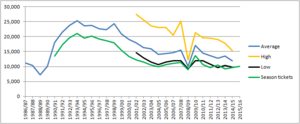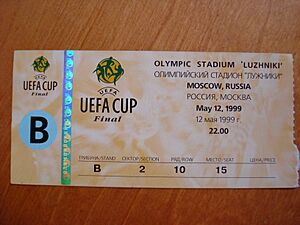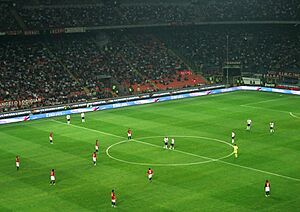History of Parma Calcio 1913 facts for kids
The history of S.S.D. Parma Calcio 1913 tells the story of a famous football club from Parma, Italy. It was started in 1913. This club grew to win many important titles both in Italy and around the world. Parma Calcio is best known for winning eight major trophies between 1992 and 2002. The club faced financial problems and went bankrupt in 2015.
Contents
- The Start of Parma Calcio (1913–1940)
- Life as a Provincial Club (1940–1968)
- Climbing Back Up (1968–1985)
- Two Promotions (1985–1990)
- Serie A and Scala's Success (1990–1994)
- More International Fame (1994–1998)
- More Success and Financial Issues (1998–2004)
- Financial Troubles Begin (2001–2004)
- Decline and Relegation (2004–2008)
- Up and Down After Ghirardi's Purchase (2008–2015)
- Another Rebirth (2015–Present)
The Start of Parma Calcio (1913–1940)
A football club was founded in Parma in July 1913. It was first called Verdi Foot Ball Club. This name honored the famous opera composer Giuseppe Verdi, who was born near Parma. The team wore unique white shirts with a black cross on the front. The club officially became Parma Football Club in December of the same year.
Parma started playing in a league during the 1919–20 season. They finished second in their regional championship. In 1922, the club's president, Ennio Tardini, planned to build a stadium. Parma had no permanent home before this. The new stadium was named Stadio Ennio Tardini in his honor. It opened the following year.
Parma played in the regional Emilian championship. They earned their first promotion in the 1924–25 season. They moved from the Seconda Divisione to the Prima Divisione. In 1929, they became founding members of Serie B, a national league. Parma played their first Serie B game on October 6, 1929. They beat Biellese 2–0. The team stayed in Serie B for three years. They were then relegated in 1932. The club changed its name to Associazione Sportiva Parma a year later. They played in Serie C for the rest of the 1930s. Their best finish was fourth in 1939–40.
Life as a Provincial Club (1940–1968)
Parma almost returned to Serie B in 1942–43. They won 17 out of 19 matches and scored 82 goals. However, they were disqualified from the final round. This was due to claims of corruption. Italian football then stopped because of World War II. Parma did play in a special championship in 1944.
After the war, Parma spent three years in Serie B. They were relegated again in 1949. They lost a play-off match against Spezia. Parma then spent five more seasons in Serie C. They finished second twice. They finally gained promotion again in 1953–54. This was helped by Július Korostelev, who scored 15 goals. William Bronzoni is still the club's record league goalscorer. He netted 78 times from 1945 to 1953.
This promotion started a successful time for the club. The team stayed in the second tier for eleven years. They often finished in the middle of the table. Their highest finish was ninth in 1954–55. This was a club record at the time. Key players from this era included Paolo Erba. He was the league's top scorer in 1956–57. Ivo Cocconi set the club's appearance record, playing 308 times.
Parma also played in Europe for the first time in 1960–61. They beat Swiss team AC Bellinzona in the Coppa delle Alpi. However, the club's performance dropped. They were relegated to Serie C in 1964–65. They finished last with only 23 points. Parma spent just one season in Serie C. They were then relegated again to Serie D in 1966. The club faced serious financial trouble. It was ordered to close down in 1968. A local team, A.C. Parmense, took over Parma. This helped the club financially and in sports. The club's name changed to Associazione Calcio Parma.
Climbing Back Up (1968–1985)
Parma won their regional division in 1969–70. This earned them promotion to Serie C. They stayed there for three years. In 1969, the club signed winger Bruno Mora. He played 21 times for Italy. He also went to the 1962 World Cup. Mora had won Serie A twice and the European Cup once. He was the first player from Parma to play for the national team. He ended his career at the club in 1971. He later managed the club for a short time in the early 1980s.
The club returned to professional football in 1972–73. They were promoted to Serie B. They won a play-off match against Udinese 2–0. However, they only spent two seasons in the league. They did manage to finish 5th in 1973–74. This was a new club record. They were relegated the next year. Parma returned to Serie C. They stayed there until their promotion in 1978–79. This was under manager Cesare Maldini.
Maldini's Parma beat Triestina 3–1 in a play-off. Two goals came from a young player named Carlo Ancelotti. He later moved to Roma. However, Parma only lasted one season in Serie B. They started the 1980s back in Serie C. In 1982–83, Massimo Barbuti joined Parma. Fans called him l'idolo della Nord, or the idol of the North. This was because of his popularity with fans in the Curva Nord. This is where Parma's most loyal fans sit.
Parma returned to Serie B as champions in 1984. Barbuti scored 18 goals that season. A final day victory over San Remo secured the title. Juventus-bound Stefano Poli scored the only goal. Parma's stay in Serie B was short. They finished third from bottom and were relegated. This disappointment led to Barbuti's departure. He scored 37 league goals in 98 games for the club. Fans loved him for his hard work and goalscoring.
Two Promotions (1985–1990)
Parma kept moving between leagues. They returned to Serie B under Arrigo Sacchi in 1986. They finished level on points with Modena. Promotion was secured on the final day. They won 2–0 against Sanremese. On that day, Alessandro Melli scored his first goal for Parma. He would later play a big role in Parma's successes.
Parma's first season back in Serie B was good. They missed promotion to Italy's top league by just three points. They also knocked A.C. Milan out of the Coppa Italia. This result convinced Milan's owner, Silvio Berlusconi, to hire Sacchi. His replacement, Zdeněk Zeman, was fired after only seven matches. Giampieri Vitali took over. He led the team to two mid-table finishes. In 1989, Nevio Scala became manager. He introduced a 5–3–2 formation. This formation would be key to much of the club's success.
Scala's Parma led Serie B at the halfway point. Despite a stadium incident and the owner's death, Parma secured a historic promotion. They beat rivals Reggiana on the final day. Goals from Marco Osio and Alessandro Melli secured promotion to Serie A on May 27, 1990. After promotion, Calisto Tanzi increased his ownership stake. He named Giorgio Pedraneschi as president. This allowed Scala to strengthen the team. Players like Tomas Brolin, Claudio Taffarel, and Georges Grun joined. They joined existing stars like Luigi Apolloni, Lorenzo Minotti, and Alessandro Melli.
Serie A and Scala's Success (1990–1994)
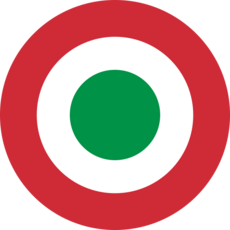
Parma's first ever game in Serie A was a 2–1 loss to Juventus. Fifteen days later, they got their first Serie A win. They beat Diego Maradona's Napoli 1–0. Parma finished their first Serie A season in sixth place. This meant they qualified for the UEFA Cup.
In the 1991–92 season, Parma exited the UEFA Cup early. This was despite adding Antonio Benarrivo and Alberto Di Chiara. Both full-backs would later play for Italy. The club did better in Italy. They finished sixth in the league. They also won the Coppa Italia final against Juventus. Parma lost the first game 1–0. But they won the home game 2–0. Alessandro Melli scored just before half-time. Marco Osio scored an hour later. This was Parma's first major trophy. In 1991, Parmalat fully bought the football club.
Parma's team got even stronger with Colombian striker Faustino Asprilla. In 1993, they won their first major international trophy. They beat Belgian side Royal Antwerp 3–1 in the Cup Winners' Cup final. This game was at Wembley Stadium in England. Goals came from captain Lorenzo Minotti, Alessandro Melli, and Stefano Cuoghi. They also achieved a record high finish of third place in the league. However, they lost the 1992 Supercoppa Italiana to A.C. Milan.
The next season, Parma won the European Super Cup. They beat AC Milan in an all-Italian final. They lost the first game at home 1–0. But goals from new players Nestor Sensini and Massimo Crippa secured the win. That same season, they lost the Cup Winners' Cup final 1–0 to Arsenal. They also dropped to 5th in the league. This was despite new signing Gianfranco Zola scoring eighteen league goals.
More International Fame (1994–1998)
The next year, Parma added Fernando Couto and Dino Baggio. They faced Juventus in another final. This time it was for the UEFA Cup. Dino Baggio scored the only goal in the first game in Parma. He scored again in the second game in Milan. This gave Parma a 2–1 win and their second major European trophy. Parma lost the Coppa Italia final to Juventus 2–1.
Despite signing Hristo Stoichkov and Filippo Inzaghi, the 1995-96 season brought no trophies. After seven years and four major trophies, Nevio Scala stepped down as manager. He was Parma's longest-serving manager. Carlo Ancelotti replaced him. The club president, Pedraneschi, was also replaced by Stefano Tanzi, son of Calisto.
Ancelotti and Tanzi immediately changed the team. They signed Hernán Crespo, Enrico Chiesa, and Zé Maria. They sold Stoichkov, Couto, Inzaghi, and Di Chiara. Gianfranco Zola, who scored 49 goals for Parma, was sold to Chelsea in November 1996. This was because he didn't fit the new team formation. Ancelotti later said he regretted this decision.
However, the star-filled team achieved Parma's best ever league finish under Ancelotti. They finished second in 1997. They were only two points behind champions Juventus. Parma then played in the Champions League for the first time. They qualified for the group stages. But they were knocked out by Borussia Dortmund, led by former Parma manager Nevio Scala. This, plus a disappointing fifth-place finish in Serie A, led to Ancelotti's sacking. Alberto Malesani was appointed. Young talents like Gianluigi Buffon, Fabio Cannavaro, and Lilian Thuram emerged. All of them would later win World Cups for their countries.
More Success and Financial Issues (1998–2004)
Malesani's first move was to sign Juan Sebastián Verón. Despite finishing fourth in Serie A, this season was Parma's most successful. They won two cup competitions. On April 14, 1999, Parma and Fiorentina drew 1–1 in the first leg of the Coppa Italia final. Crespo scored for Parma. Crespo scored twice in the second leg, which ended 2–2. Parma won on the away goals rule, lifting their second Coppa Italia.
Just three days earlier, Parma won their second UEFA Cup. They beat Marseille 3–0 at the Luzhniki Stadium. Crespo scored early. Paolo Vanoli added a header before half-time. Enrico Chiesa scored a volley to seal the win.
Parma won the Italian Super Cup early the next season. They beat league champions A.C. Milan. However, the sale of Verón and an early Champions League exit disappointed fans. Parma finished fourth in the league again. They lost a play-off to Internazionale. This meant they played in the UEFA Cup again.
That summer, Hernán Crespo was sold to Lazio for a world record transfer fee. Matías Almeyda and Sérgio Conceição came to Parma. Part of the money was used to buy Savo Milošević. Parma had a difficult season. Malesani was replaced by Arrigo Sacchi in January 2001. Sacchi soon left due to poor health. New coach Renzo Ulivieri took over. He led the team to fourth in the league. This secured Champions League qualification. However, Parma lost the Coppa Italia final to Fiorentina.
Financial Troubles Begin (2001–2004)
The sale of Gianluigi Buffon and Lilian Thuram to rivals Juventus for a lot of money led to a bad start to the 2001-02 season. Parma also had another early Champions League exit. Ulivieri was sacked in October. Daniel Passarella was hired and fired two months later. Pietro Carmignani became head coach. He helped Parma win their most recent trophy. Parma faced Juventus in another major final, the Coppa Italia. Juventus won the first game 2–1. Hidetoshi Nakata's late goal was very important. Parma won the second game 1–0 with an early goal from Júnior. This gave Parma the win on away goals and their third Coppa Italia. A good run of form late in the season saved Parma from being relegated. By 2002, all players from the 1999 UEFA Cup winning team had left. Parma was known as one of the "Seven Sisters" of Italian football. These teams dominated Italian football in the 1990s and early 2000s.
Cesare Prandelli became Parma's new manager in May 2002. However, more players were sold to raise money. Fabio Cannavaro went to Internazionale. Marco Di Vaio went to Juventus. Johan Micoud went to Werder Bremen. Parma lost the 2002 Supercoppa Italiana to Juventus. But the team still finished fifth. Goals from Adrian Mutu and Adriano helped. Strong defense came from Daniele Bonera and Matteo Ferrari.
The next season, Parma faced more challenges. Mutu was sold to Chelsea. Star striker Adriano was injured. The parent company, Parmalat, faced a huge financial scandal. President Calisto Tanzi was arrested for stealing money. The club was reformed under a new name, Parma Football Club. Despite these problems, they finished fifth again. This was largely due to Alberto Gilardino, who scored 23 league goals. On April 28, 2004, the club was declared bankrupt. Calisto Tanzi resigned in January 2004.
Decline and Relegation (2004–2008)
After years of financial crisis, Parma A.C. was renamed Parma F.C. in June 2004. Manager Prandelli left before the 2004–05 season. The club also returned to its traditional white shirts with black crosses. This replaced the yellow and blue colors from Parmalat's ownership. The club had to change its financial model. Matteo Ferrari and Matteo Brighi were sold to Roma.
Parma reached the semi-finals of the UEFA Cup. But they had their lowest league finish in fifteen years. They hired and fired Silvio Baldini. Pietro Carmignani took over. This was despite Gilardino scoring another 23 league goals. Parma's league position meant they had to play a two-game play-off. They faced Bologna to stay in Serie A. They won the play-off 2–1.
The club was still for sale. Enrico Bondi became president. He continued to sell Parma's best players. Alberto Gilardino left for A.C. Milan in 2005 for €25 million. He had scored 50 league goals in 95 matches. French goalkeeper Sébastien Frey went to Fiorentina. Parma finished tenth the next season. But the Calciopoli scandal changed their official position to seventh. This meant they returned to the UEFA Cup. Players like Daniele Bonera were still sold for money. Stefano Pioli was appointed as the new coach for the 2006–07 season.
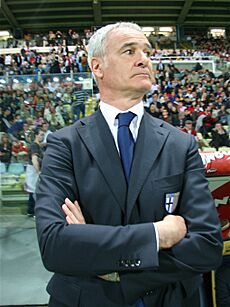
On January 24, 2007, Tommaso Ghirardi became the new owner of Parma FC. He was a 31-year-old businessman. Ghirardi also became president. This ended three years of state control. Parma qualified for the Round of 32 in the 2006–07 UEFA Cup. But they were knocked out by S.C. Braga. The home game was played without fans. This was because the stadium did not meet new safety rules.
On February 12, Parma fired coach Pioli. They were second-last in the league. Claudio Ranieri replaced him. Against tough odds, Ranieri helped Parma avoid relegation on the final day. He left at the end of the season. In the 2007–08 season, Parma again fought against relegation. Three different coaches took charge. But none could keep Parma in Serie A. They lost 2–0 at home to champions Internazionale on the final day. Zlatan Ibrahimović scored the goals that sent them down. Parma was relegated to Serie B after eighteen years in the top league.
Up and Down After Ghirardi's Purchase (2008–2015)
Parma's time in Serie B started badly. Luca Cagni was sacked after six games. Francesco Guidolin replaced him. He guided the club to second place. They finished the season unbeaten at home. Goals from Alberto Paloschi and Cristiano Lucarelli helped. Parma secured promotion back to Serie A on May 16, 2009. They finished second in the league.
Parma's return to Serie A in 2009–10 started well. They won eight of their first sixteen matches. They were in fourth place before Christmas. Daniele Galloppa became the first Parma player to play for Italy in over three years. Parma's form dropped in the new year. But they still finished eighth. They just missed out on qualifying for the Europa League. Coach Guidolin's contract was not renewed. He left for Udinese. Pasquale Marino became Parma's new manager in 2010.
Parma started the 2010–11 season poorly. They were in sixteenth place at Christmas. Hernán Crespo had scored eight goals. Pressure grew on Marino. Marino was sacked on April 3. This was after a disappointing home loss to Bari. Parma was only two points from the relegation zone. Franco Colomba was appointed as his replacement.
Colomba brought a big change. He won four of his seven games. This included three wins against top teams. They also beat rivals Juventus twice that season. They avoided relegation the weekend before the last game. On January 9, 2012, Ghirardi sacked Colomba. Roberto Donadoni replaced him. Donadoni's team finished the season with 7 wins in a row. This was a new club record in Serie A. They finished an impressive eighth.
The club was declared bankrupt in 2015. They had to restart from Serie D.
Another Rebirth (2015–Present)
The re-founded club, S.S.D. Parma Calcio 1913, was formed in July 2015. It took its name from the year the original club was founded. It secured a place in the 2015–16 Serie D. Former head coach Nevio Scala was appointed as president. Former player Luigi Apolloni was chosen as head coach. In the club's first season, they sold over 9,000 season tickets. This more than doubled the Serie D record. They won their first game in Serie D 2–1 against Villafranca Veronese. 10,000 supporters were there.


